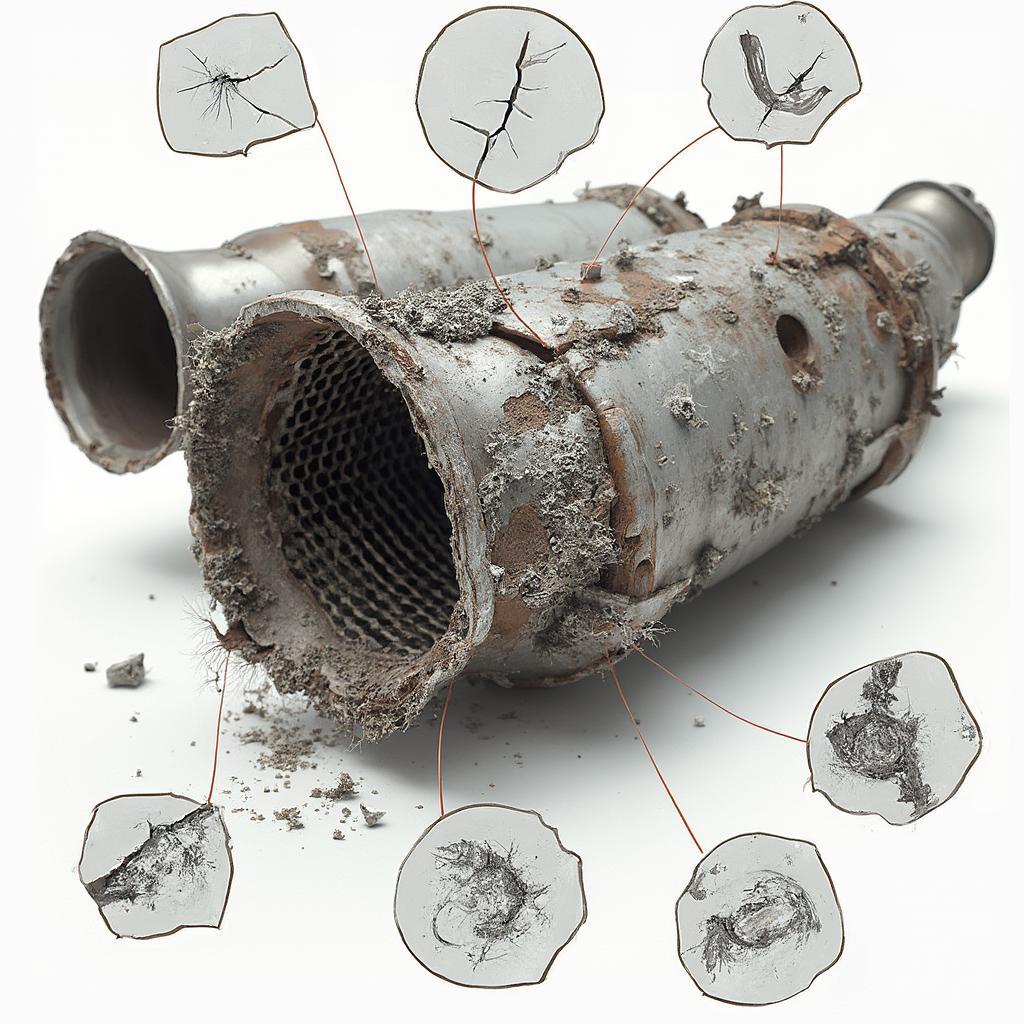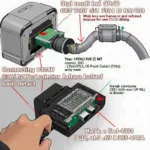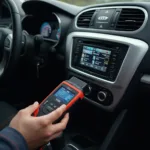The OBD2 diagnostic trouble code (DTC) “catalyst outside of threshold” can be a frustrating experience. It indicates a problem with your vehicle’s catalytic converter efficiency, and understanding what it means and how to address it is crucial for maintaining your car’s performance and minimizing emissions. Let’s delve into the details of this common OBD2 code.
What Does “OBD2 Catalyst Outside of Threshold” Mean?
This DTC signifies that the oxygen sensors downstream of the catalytic converter are detecting oxygen levels similar to those upstream, indicating the converter isn’t effectively converting harmful exhaust gases. The “threshold” refers to the acceptable range of oxygen sensor readings that indicate proper catalytic converter function. When this threshold is exceeded, the OBD2 system triggers the “catalyst outside of threshold” code.
Why is My Catalyst Efficiency Outside the Threshold?
Several factors can contribute to this issue, ranging from minor sensor malfunctions to serious catalytic converter damage. Common causes include:
- Faulty Oxygen Sensors: A malfunctioning oxygen sensor can provide inaccurate readings, triggering the DTC even if the catalytic converter is functioning correctly.
- Exhaust Leaks: Leaks in the exhaust system before the downstream oxygen sensor can introduce fresh air, skewing the sensor readings and causing a false positive.
- Rich Fuel Mixture: A rich air-fuel mixture can overload the catalytic converter, reducing its efficiency and triggering the code. This can be caused by problems with fuel injectors, the mass airflow sensor, or other fuel system components.
- Damaged Catalytic Converter: Physical damage to the converter, such as from impact or overheating, can impair its ability to function properly. Internal contamination, often caused by engine oil or coolant entering the exhaust system, can also poison the catalyst and reduce its efficiency.
Troubleshooting the “OBD2 Catalyst Outside of Threshold” Code
Diagnosing the exact cause requires a systematic approach. Here’s a suggested procedure:
- Scan for Other Codes: Check for other DTCs that might be contributing to the problem, such as misfire codes or oxygen sensor codes.
- Inspect Oxygen Sensors: Visually inspect the oxygen sensors for damage or contamination. Test the sensors using a multimeter to verify their functionality.
- Check for Exhaust Leaks: Inspect the exhaust system for leaks, particularly between the engine and the downstream oxygen sensor. A soapy water solution can help identify leaks.
- Inspect Fuel System: Examine the fuel injectors, mass airflow sensor, and other fuel system components for issues that might be causing a rich fuel mixture.
- Test Catalytic Converter: Specialized tests can assess the catalytic converter’s efficiency. These tests typically involve measuring backpressure and comparing oxygen sensor readings.
What if the Catalytic Converter is Bad?
If the catalytic converter is confirmed to be faulty, replacement is usually necessary. Aftermarket converters are often a more affordable option, but ensure they meet your vehicle’s specifications.
How to Prevent “OBD2 Catalyst Outside of Threshold” Issues
Regular maintenance can help prevent future problems. This includes:
- Regular Tune-Ups: Ensure your engine is running efficiently to minimize strain on the catalytic converter.
- Address Engine Issues Promptly: Fix misfires, oil leaks, and coolant leaks as soon as they occur to prevent contamination of the catalytic converter.
- Use Quality Fuel: Using the correct fuel type and avoiding contaminated fuel can help protect the converter.
“Regular preventative maintenance is key to a healthy catalytic converter,” advises John Smith, ASE Certified Master Technician. “Addressing minor issues early can prevent costly repairs down the line.”
Conclusion
The “obd2 catalyst outside of threshold” code signals a potential problem with your vehicle’s emissions system. While a faulty oxygen sensor or exhaust leak could be the culprit, a damaged catalytic converter is a common cause. By understanding the potential causes and following the troubleshooting steps outlined above, you can effectively address this issue and ensure your vehicle is running efficiently and cleanly. Ignoring this code can lead to further damage and more expensive repairs.
FAQ
- Can I drive with a “catalyst outside of threshold” code? While you might be able to drive, it’s not recommended. Ignoring the code can lead to further damage and failed emissions tests.
- How much does a catalytic converter replacement cost? The cost varies depending on the vehicle and the type of converter, but it can range from several hundred to over a thousand dollars.
- How long does a catalytic converter last? A catalytic converter typically lasts for 100,000 miles or more, but various factors can affect its lifespan.
- What are the symptoms of a bad catalytic converter? Common symptoms include reduced engine performance, a sulfur-like smell from the exhaust, and a rattling sound from under the vehicle.
- Can a faulty oxygen sensor cause this code? Yes, a faulty oxygen sensor can provide inaccurate readings, triggering the “catalyst outside of threshold” code.
- How can I prevent catalytic converter problems? Regular maintenance, addressing engine issues promptly, and using quality fuel can help prevent problems.
- Is an aftermarket catalytic converter a good option? Aftermarket converters are often more affordable, but ensure they meet your vehicle’s specifications.
Common Scenarios for “OBD2 Catalyst Outside of Threshold”
- Scenario 1: A car experiences reduced fuel economy and a decrease in engine performance along with the “catalyst outside of threshold” code. This could point towards a failing catalytic converter.
- Scenario 2: The code appears intermittently after a recent repair on the exhaust system. This might indicate an exhaust leak.
- Scenario 3: The code appears along with an oxygen sensor code. Replacing the faulty oxygen sensor might resolve the issue.
Related Articles and Questions
You may also find these articles helpful: obd2 err.
For further assistance, contact our 24/7 customer service via WhatsApp: +1(641)206-8880, Email: [email protected] or visit us at 789 Elm Street, San Francisco, CA 94102, USA.


